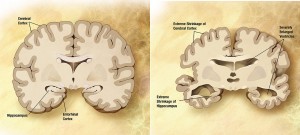[retweet][facebook]
Electron microscopy reveals that acupuncture and moxibustion protect Alzheimer’s disease patients’ brain cells. Published in Neural Regeneration Research, laboratory experiment findings identified major brain structures that are preserved by using electroacupuncture and moxibustion. The research team documented a powerful neuroprotective effect induced by electroacupuncture including specific beneficial changes in brain chemistry.
 Acupuncture is the insertion of needles used to induce physiologic responses and moxibustion is the burning of herbs near the skin to produce a warming effect. Moxibustion is often used to enhance the micro-circulation of blood to local regions of the body, especially over acupuncture points. In this study, acupuncture was applied to acupuncture points GV20 (Baihui) and BL23 (Shenshu) on laboratory rats with induced Alzheimer’s disease pathology. The brains were examined with electron microscopy which revealed that rats treated with electroacupuncture had a preserved structure of a part of the brain called the hippocampus. The researchers note that “neuronal cell injury was markedly reduced” as a result of acupuncture. The control group that received no acupuncture or moxibustion showed enormous damage to the hippocampus.
Acupuncture is the insertion of needles used to induce physiologic responses and moxibustion is the burning of herbs near the skin to produce a warming effect. Moxibustion is often used to enhance the micro-circulation of blood to local regions of the body, especially over acupuncture points. In this study, acupuncture was applied to acupuncture points GV20 (Baihui) and BL23 (Shenshu) on laboratory rats with induced Alzheimer’s disease pathology. The brains were examined with electron microscopy which revealed that rats treated with electroacupuncture had a preserved structure of a part of the brain called the hippocampus. The researchers note that “neuronal cell injury was markedly reduced” as a result of acupuncture. The control group that received no acupuncture or moxibustion showed enormous damage to the hippocampus.
Examination using a transmission electron microscope showed that electroacupuncture and moxibustion benefitted the biochemistry of the brain. Electroacupuncture and moxibustion successfully downregulated axin protein expression and upregulated beta-catenin protein expression. This was true for all three treatment groups: electroacupuncture only, moxibustion only and a thrid electroacupuncture combined with moxibustion group.
The electroacupuncture and moxibustion treatments were given prior to the onset of the pathology. The neuroprotective effects of electroacupuncture and moxibustion are associated with treatment prior to the onset of brain damage, pretreatment. This supports the use of acupuncture and moxibustion as preventative medicine. The research team reports, “The present study demonstrates that electroacupuncture pretreatment has a neuroprotective function in the hippocampus, suggesting that this technique could be used to protect learning and memory functions, and prevent senile dementia.” They added that in the hippocampus “neuronal cell injury was markedly reduced in all three pretreatment groups; organelles were visible in the cytoplasm, and chromatin appeared normal.”
Research
The impetus for the investigation was the publication of prior research demonstrating that acupuncture point BL23 “improves impaired learning and memory.” Additional research was cited demonstrating that acupuncture at GV20 and BL23 “regulate acetylcholinesterase activity, elevate cortical excitability and cerebral blood flow, improve cerebral circulation, protect against free radical oxidation and neurotoxic injury, suppress inflammation and cell apoptosis, improve learning and memory functions, and effectively treat senile dementia.” The research team also cited an experiment demonstrating moxibustion as an effective modality for preventing and treating senile dementia.
The current study demonstrates that electroacupuncture and moxibustion protect the ultrastructure of the hippocampus. The research team notes that the study is of high quality in that it is easily repeatable, has exact parameters and scientifically demonstrates the same results in every repeated investigation. They added that the best results identified in the study were achieved by combining electroacupuncture with moxibustion. They noted, “The combination of moxibustion and electroacupuncture obtained a better neuroprotective effect than either technique alone….”
How Acupuncture Works
The research team postulated how acupuncture exerts a neuroprotective effect on the brain. Both electroacupuncture and moxibustion regulate axin and beta-catenin in the brain. The proteins interact with each other and are an integral part of Wnt signaling pathways, a group of signal transduction pathways composed of proteins that signal from outside a cell to it interior. The researchers note, “We therefore propose that the mechanisms of action underlying the potential benefits of acupuncture and moxibustion in the prevention and treatment of Alzheimer’s disease involve the regulation of Wnt signaling via alterations in axin and β-catenin expression.” The researchers state that electroacupuncture and moxibustion stimulate a homeostatic response to axin and beta-catenin protein expression thereby activating a Wnt signaling pathway that helps protect brain cells by regulating communication through cell walls.
The research documents specific structures of the brain that are protected by acupuncture and moxibustion in a rat model of Alzheimer’s disease. These findings suggest that patients who are predisposed to the disease or show signs of its onset will benefit greatly from preventative acupuncture treatments. The researchers did not outline specific protocols for treatment but cited numerous studies showing that BL23 and GV20 are effective acupuncture points. The team translated the biomedical research on these points into Traditional Chinese Medicine (TCM) differential diagnosis concepts. They note that BL23 and GV20 active to “replenish the kidney essence and marrow, and promote resuscitation.”
Excerpt from:
Electron Microscope Reveals Acupuncture Helps Alzheimer’s Patients
